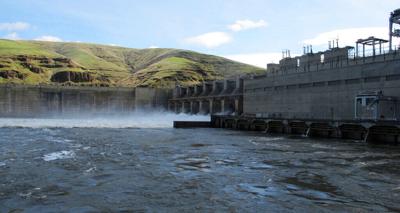(The Center Square) – Multiple issues need to be addressed before considering whether four federal hydroelectric dams on the lower Snake River in Washington state could, or should, be removed, U.S. Sen. Patty Murray, D-Washington, said Wednesday during a stop at Big Bend Community College in Moses Lake.
As part of her visit, the senator toured the college's new vocational/tech center and participated in a roundtable discussion on emerging clean energy technology manufacturing in the area.
“As you know, it has been a long-time topic discussion in our state … [but] we cannot remove the Snake River dams at this point because of all those issues,” Murray said.
Some environmental groups and Native American tribes want the dams breached, insisting that a free-flowing river will restore steelhead and endangered salmon runs. Notice was recently given to the U.S. Army Corps of Engineers, which operates the dams, that a new lawsuit toward that end is pending.
Barring a possible future court order, Congress would ultimately decide if the federally owned dams would be removed, then appropriate money for the work, which would be monumental in scope.
Murray, who chairs the Senate Appropriations Committee, acknowledged that salmon recovery “is very important,” but said other interests are, too. She referred to a study supported by her and Gov. Jay Inslee released a year ago that concluded benefits provided by the dams must be replaced before Congress considers removing them.
“The governor and I spent a great deal talking to everybody who’s involved in this, from agriculture to people who use the river for transportation to the tribes to the communities themselves involved, and came to the conclusion that, we cannot remove the Snake River dams at this point,” Murray said.
A draft report released last year concluded that benefits provided by the facilities would cost between $10.3 billion and $27.2 billion to replace.
Located in southeast Washington state between the Tri-Cities and Lewiston, Idaho, the dams collectively produce an average of 900 megawatts of zero-carbon energy each year, according to a study commissioned by the Bonneville Power Administration.
The dams also make a 150-mile stretch of the Snake River navigable between Lewiston and its confluence with the Columbia River, enabling barges to carry wheat and other commodities to ocean ports near Vancouver and Portland. Eliminating the dams would require additional truck and rail transportation, producing more hydrocarbon emissions and increased congestion and wear on roadways.
The dams’ infrastructure also provides flood control, irrigation water for farmers, and recreational opportunities for the public.
“I think that the governor and I were very clear in our study that our region is not ready for that decision today,” Murray said of removing the dams. “We do not have the transportation infrastructure, we don’t have the replacement for energy, we don’t have the replacement for water. And if we ever were to that point, we’ve got a lot of work to do to get there. So, for those people who are saying that’s what we need to do, we’ve given them a challenge and you show us how we’re going to solve this problem.”
In June members of the U.S. House Committee on Natural Resources visited the dams and discussed what U.S. Rep. Dan Newhouse, R-Washington, said is “the critical role they play in the Pacific Northwest’s river commerce, agricultural productivity, and energy production.”
In a news release issued at the time, Newhouse said the dams account for about 8% of Washington’s electricity, enough to power over 800,000 homes, surpassing the state’s combined output of wind and solar energy. He also said 50% of the nation’s exported wheat travels by barge through the river system, and that “doom-and-gloom” predictions of the pending extinction of Wild Chinook salmon populations “have been thoroughly debunked.”
“The good news is that Congress alone has the authority to preserve or breach these critical infrastructure projects,” he said.
In contrast, the environmental group Columbia Riverkeeper says the four dams and their turbines create “warm, shallow lakes” with predators that have decimated salmon and steelhead returns to prime breeding areas at the Snake River’s headwaters in Idaho, while generating only “a small amount of electricity.”
In July, Columbia Riverkeeper, along with the Idaho Conservation League, the Northwest Sportfishing Industry Association and Idaho Rivers United, submitted a letter providing 60 days’ notice of intent to sue the Army Corps of Engineers for violating the federal Endangered Species Act. The Corps is accused of creating hot water conditions which injure and kill Snake River sockeye salmon.









